Maggie Grey is a contemporary British textile artist. As the former editor of The World of Embroidery magazine for the Embroiderers’ Guild and the current editor of Workshop on the Web – which is now a series of leading publications for D4Daisy Books – she is often referred to as an ‘innovator of embroidery techniques’.
 One of her distinguishing traits is her ability to embrace technology. As she continues to explore, reinvent and experiment with computer aided designs, materials, compositions and techniques, Maggie continually reaffirms her place in the textiles world as an influential pioneer of modern textiles. And we’re grateful that she continues to teach online, write and exhibit work internationally.
One of her distinguishing traits is her ability to embrace technology. As she continues to explore, reinvent and experiment with computer aided designs, materials, compositions and techniques, Maggie continually reaffirms her place in the textiles world as an influential pioneer of modern textiles. And we’re grateful that she continues to teach online, write and exhibit work internationally.
Maggie is a firm believer in the importance of self exploration and continually promotes individual design. It was a great honour to discuss Maggie’s work and inspiration with her because these are the core disciplines that are so intrinsic to our own City & Guilds courses.
What was your first memory of embroidery – who taught you?
I came to embroidery through a strange series of events. For our very first Christmas together (oh so many years ago), Clive gave me watercolours, good paper and drawing pens. I was pretty awful at first but persevered. In a search for texture, I laid down some cotton threads on the paper, just stabbing long stitches by hand. By chance, I found a book, ‘Thread Painting’, by Liz Hubbard, which, quite literally, changed everything for me. Liz described a method of free stitching with a sewing machine on painted calico. Using an old Singer, I stuck at it until I mastered it and produced work that pleased me. When I attended City & Guilds classes, I was the one who didn’t know how to hand embroider and the only one who could machine embroider. Now I hand-stitch a lot.
![]()
Sad Madonna: Heavily machine embroidered work, based on an icon. I am working on some new icon pieces but they are only at the sketchbook stage, so far.
Tell us about some of the projects you are currently working on.
At the moment, I’m obsessed with words. My last book, ‘Long Diaries and Tall Tales’, was intended to be about methods of compiling travel logs and diaries with materials for wall-hangings. However, part way through, I was hi-jacked by the idea of myths and legends, which led to a series of panels that tell a story. My husband, Clive, is good at producing what he calls pseudo-calligraphy, so we worked together and it was great fun. I’m still pursuing some of the ideas by making a series of concertina books using distorted lettering as a design source.
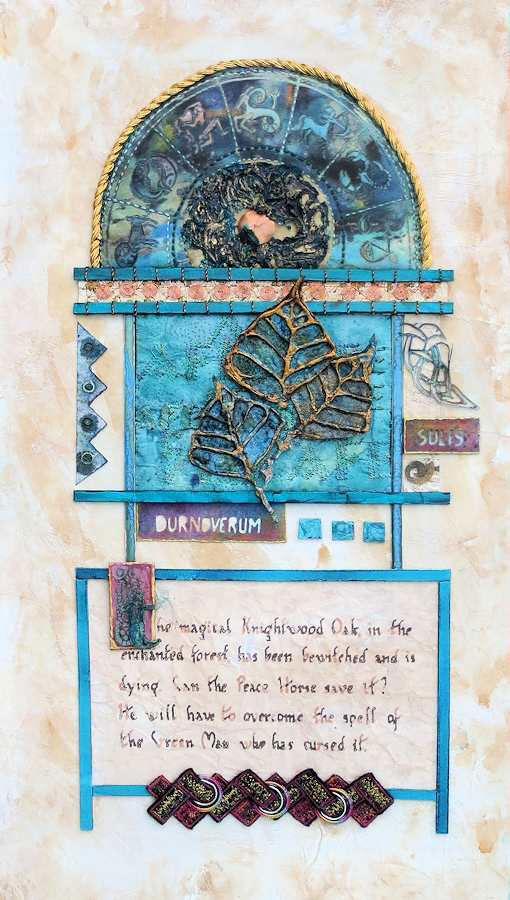

left: A collaboration with Clive that tells a tale of peril and rescue in the New Forest, near our home. Right: Peace-seeking in the Land of Myth and Legend. A mixed media piece that tells a story.
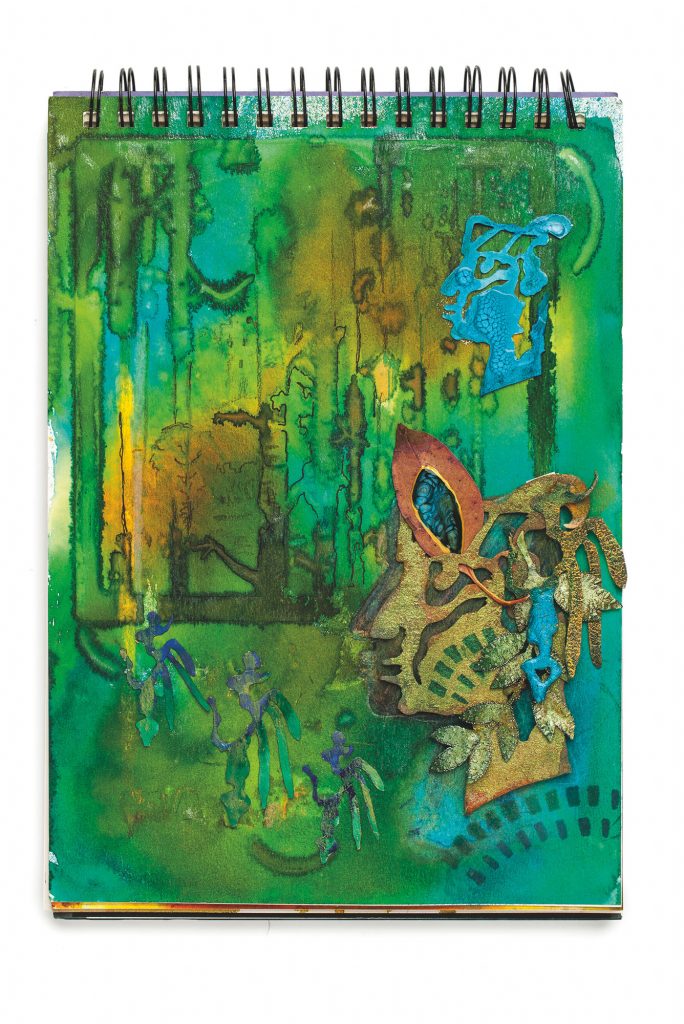
Sketch-book that inspired the Peace-seeking piece.
what are your feelings towards individual creativity?
I think everyone has that spark but it’s easily extinguished. Many people are told at an early age that they can’t draw or can’t paint instead of being offered alternatives to explore. I don’t think that art and design are alone in this negativity. I belong to an unaccompanied singing group which includes a number of people with wonderful voices, who were told at school that they couldn’t sing. I am often inspired to produce work based on our songs. I made a vessel for my section of WOWbook 1, which was based on a song called ‘River Chat’.
What sort of changes have you seen in the craft over time and any predictions for future trends?
Technology has moved everything forward. When my friend Valerie Campbell-Harding and I used to ‘team-teach’ computer textile design, we were in the minority and there was only one software package that was suitable. Now lots are available and domestic sewing machines can produce computer-enhanced effects, although these are often a little predictable. Future trends worry me as I consider the demise of City & Guilds classes have resulted in a lack of design skills. It is good to see that organisations like ‘School of Stitched Textiles’ are promoting them.

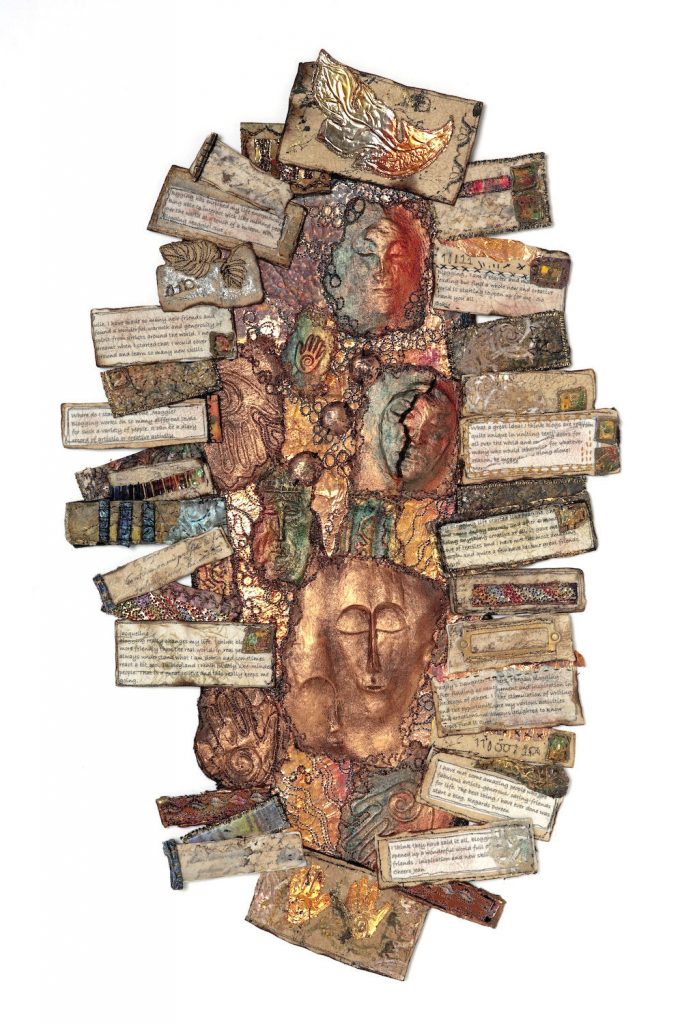
Binary Humanity: This mixed media work was exhibited, by invitation, in South Carolina. The exhibition was inspired by the use of computer technology and mine was based on the fact that every digital interaction was linked to hands on the keyboard and a face peering at the screen. I asked for comments on the subject on my blog and included them around the edge.
What has been the highlight of your career so far?
Am I allowed to have two highlights? One was during my days of teaching City & Guilds classes when one of my students, Elli Woodsford, won the Gold Medal for Excellence. Her work was outstanding. The other highlight was being asked to work with a team at the Royal College of Art, producing textbooks on textile design for use in schools. Meetings at the RCA were so exciting and you never knew which famous artist would be standing next to you in the canteen lunch queue. This experience set me up well for editing The World of Embroidery magazine for the Embroiderers’ Guild and writing books, first for Batsford and then for D4Daisy Books.
Which artists inspire you personally?
Textile Artists: My friend Jane Wild who does wonderful things with paper. Val Campbell-Harding, who was my great inspiration, friend and book writing partner. I still miss her a lot. Jan Beaney, Jean Littlejohn and Jean Draper, always give me ideas. I am also inspired by artists of the past: Piper, Picasso, Braque, Hundertwasser and, at present Archibald Knox – the Art Nouveau guru from the Isle of Man. His lettering style is inspiring my current work.
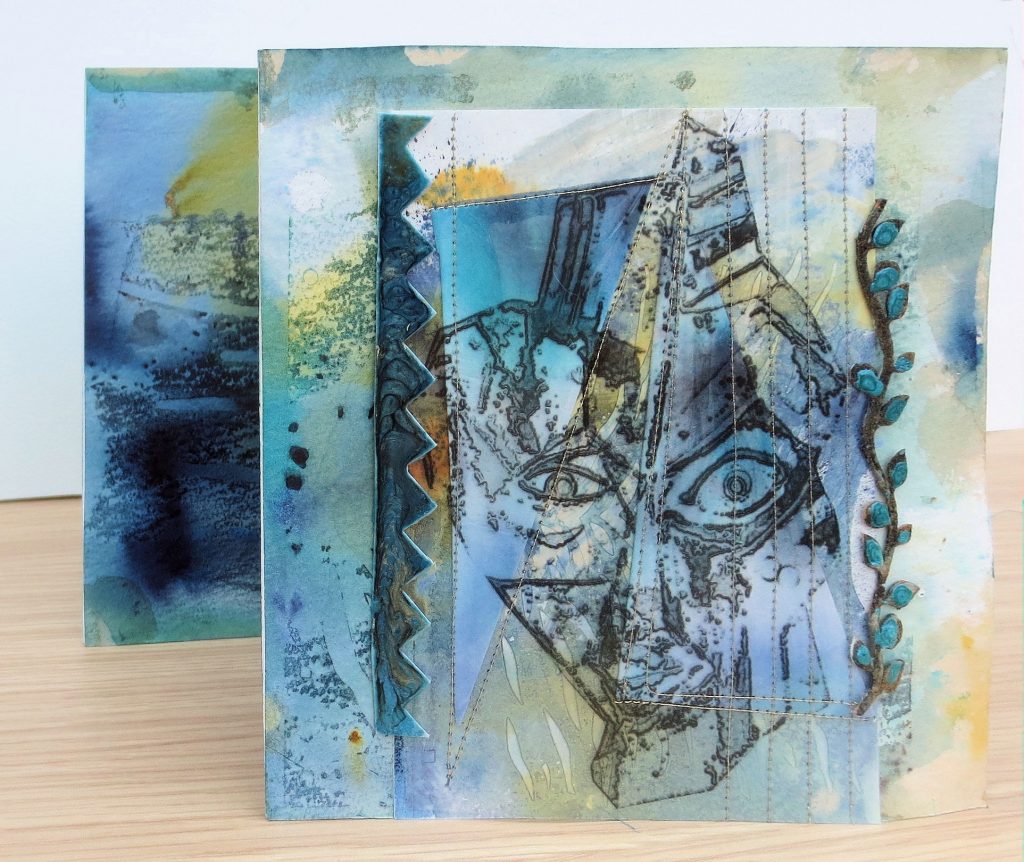
Concertina book inspired by Picasso: A drawing was scanned into a design program and printed on acetate. This was placed over painted paper and fragments of stitching.
What’s your development process for your designs, if any?
Drawings are usually the beginning, followed by lots of sketch book experiments, during which an idea morphs into something quite different. I still use the computer and a digital cutter, often stitching on printed paper, which echoes cut shapes. I love working with paper moulds and sometimes these form part of the design process, sometimes the final piece.
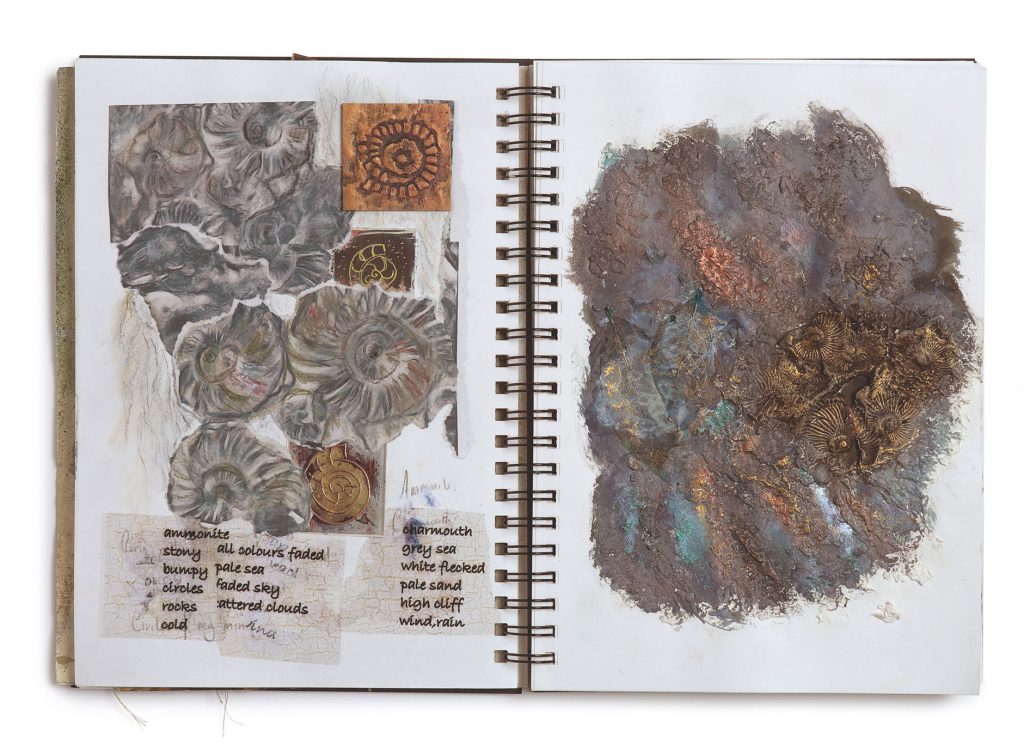
Sketchbook based on fossils from the Jurassic coast: I often write down the impression of the day, such as the sky colour etc. This is often easier than trying to reproduce it with limited resources. Lots of work resulted from this sketchbook.
How did you develop your own style and inner voice?
I’m still working on it. When I feel I’ve stopped evolving, I’ll hang up my needle! I guess I incorporate processes from the past but I’m a great butterfly and need to try new things. The past is only useful for being fairly sure of what doesn’t work.
Do you ever feel de-motivated, if so how do motivate yourself on these off days?
Yes, everyone has these days, I’m sure. I find it best to leave my work and have a long walk, followed by a session immersing myself in books about favourite artists. I am often roused from this torpor by the need to protest about something. My triptych, ‘Metaphor’ was about the arms trade. The flowers represent something good covering something evil – arms deals presented as trade agreements, for instance.
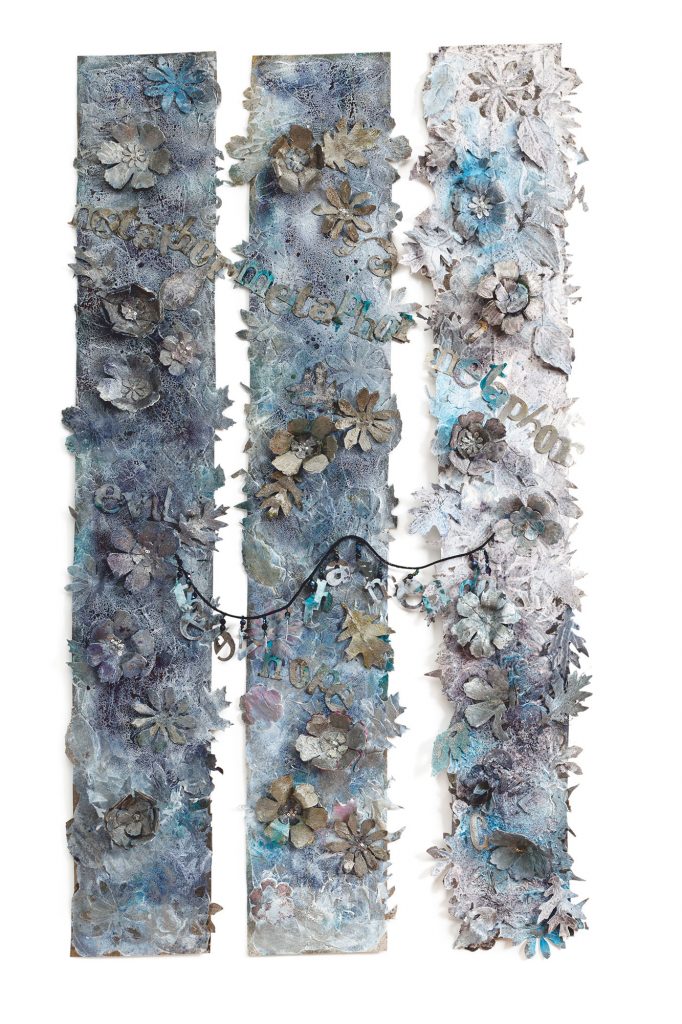
Metaphor: Flowers cut from Vilene with a die-cutter. Gesso and ink were the colouring agents.
What advice would you give to students who are undertaking courses with us?
Try to relax and enjoy the process. Don’t compare your art with others – you are unique and so is your work. Be prepared to experiment but don’t be disappointed if they don’t all work. Do spend time looking at painters, engravers, calligraphers – their work can spark off all manner of ideas.
Exhibition: Maggie has a retrospective exhibition at the Dorset Art & Craft Association, Purbeck School, Worgret Road, Wareham, Dorset BH20 4PF. On from Friday 3rd – Tuesday 7th August, 10am to 5pm (4pm on Tuesday).
Maggie Grey is the writer and/or editor of many books – the latest of which is Maggie Grey’s WOWbook2
We’d like to thank Maggie for taking the time to talk to us and share her work. If you’ve been inspired by Maggie Grey (why wouldn’t you be?) then please take a look at our range of beginner courses and City & Guilds accredited courses to find out how you can unlock your own personal creativity.


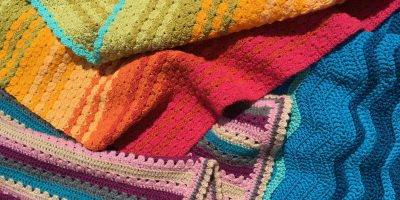




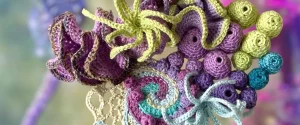
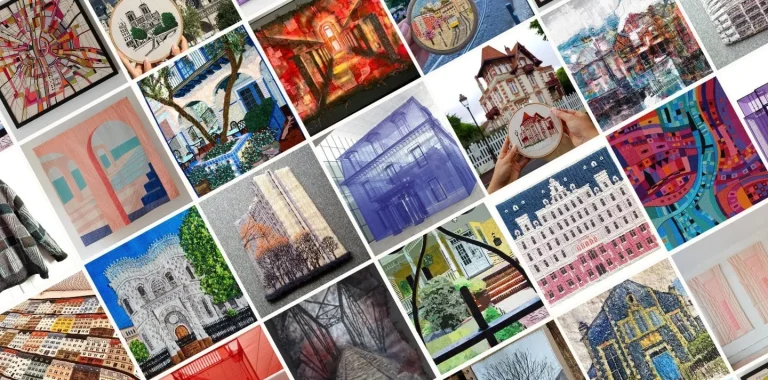
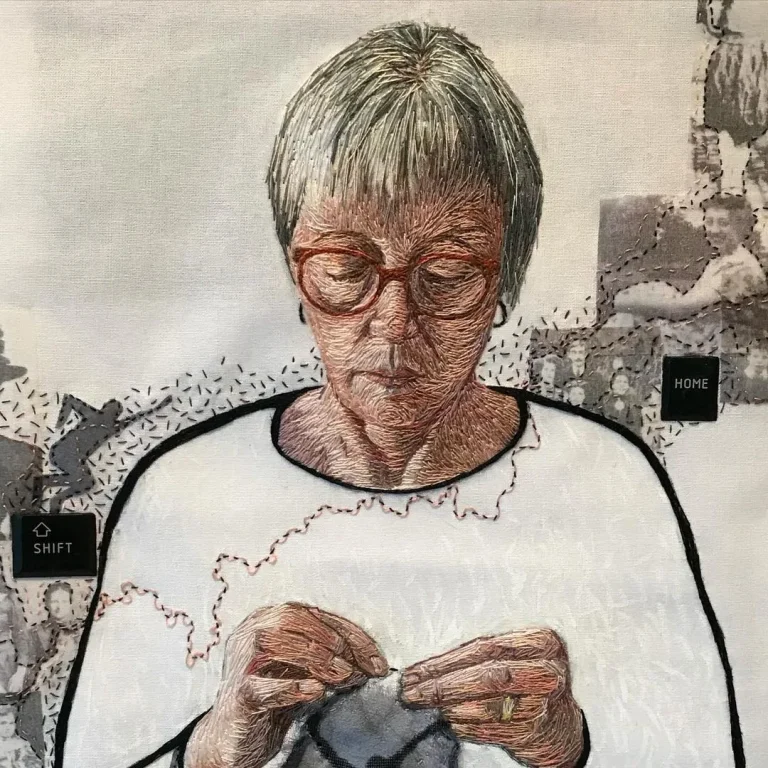
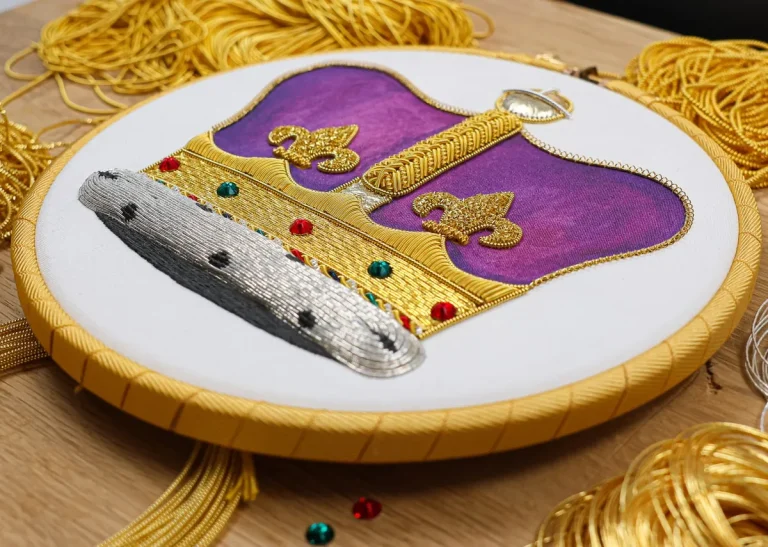
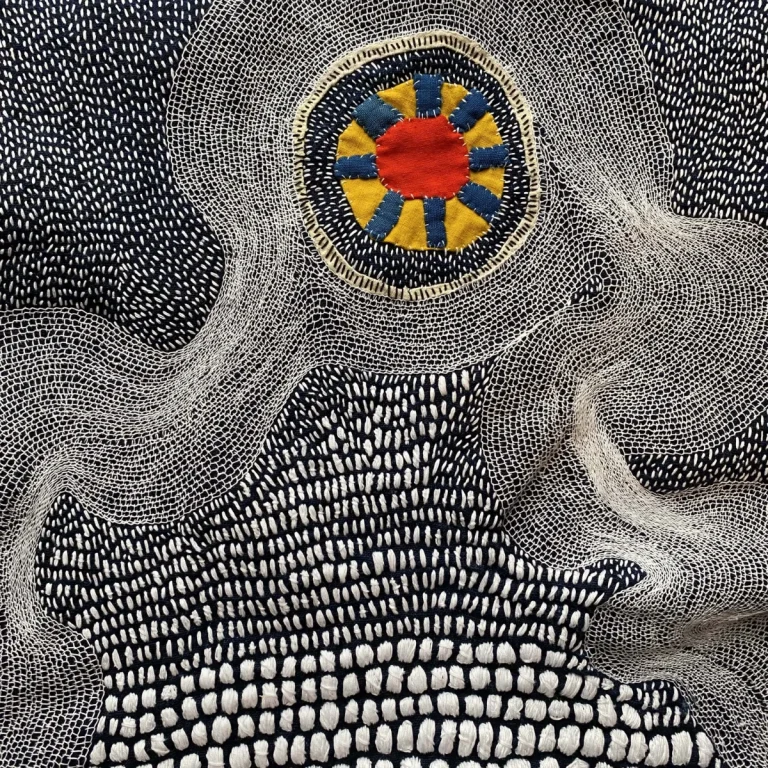
13 Comments
Thank you all at sst for writing such a lovely piece about me. I do think that courses like these are so important and need all our support. I forgot to say in the text that the idea of using print-on acrylics came from Steph Redfern (with permission, of course). It was in her Stitched Textiles:Nature book which I reviewed and loved.
Thank you too, for such a wonderful, insightful interview, Maggie. It’s also a huge boost for all of the tutors and staff that you’re so supportive of our courses and textile education in general.
This interview explains why I have always been inspired & uplifted by Maggie Grey…Passion…understanding …combined with a love of beauty & humanity.So very gifted
I loved the article. I am so thankful for Maggie Grey and all she has done to inspire me and so many people. I have many of her books, subscribed to her WOW online and now with her WOWBOOKS I am trying all kinds of new materials and techniques. I have never had so much fun or been so inspired!
Just wanted to say that Maggie Grey has been a great influence. I used to belong to the computer textile design group that she mentions and I don’t think I would have bought a computer in those days if I hadn’t been inspired by her. She still inspires today via her books, especially WOWbooks with their extra online lessons. Keep up the good work Maggie.
I love to hear how others are inspired and also believe it’s so important to develop yourself and not feel restricted by what others do
I have followed Maggie’s beautiful work for a long long time. Her books fill my library. She continues to inspire me, leading me to continually try new and unusual methods. She is a marvelous artist
I have always been inspired by Maggie’ work enthusiasm and wish to explore new ways. As a retired textile teacher who now teaches adults I am always looking for new ideas to stretch my students and of course myself. They come in the form of all Maggie’s books and online tuition. Please keep it coming as there are plenty of ‘sponges’ out there.
What a great interview which evoked such wonderful memories of attending Maggie’s course on computer textile design and so many classes with Val Campbell- Harding too. An early computer textile design class with Val involved setting up the camera on a tripod to photograph the results from the computer screen – because we would never afford colour printing! How spoilt we are to have the ability to print and photocopy at home – I try never to take it for granted, or the inspiration from people like Maggie. Thank you!
Thank you all so much for those lovely comments. Jane – I remember the photos of the screen and the courses that Val and I used to run. It’s all much easier now. Louise – we did have fun, didn’t we?
Pingback: Jan Horrox: The Versatility of Cloth Dolls | School of Stitched Textiles
Hi Maggie,
I’m Jill Packer, Sam Packer is my daughter in law and you came to my house several years ago.
We are down in Poole for our monthly visit and I just wanted to let you know that there is a guy at Wimborne market on a Friday selling large pieces of glove leather for £2 a piece. They have tiny flaws so can’t be used in the trade.
He is very helpful and also sells smaller pieces for £1, …I now have a small collection and hope to use them for my Contemporary Quilts sometime.
I just thought you may be interested or know people who would.
He doesn’t have a website because each piece is different but here is his name and email in case you are interested.
I’m not sure this is the best way to contact you and I can’t send a photo, but I was looking at your books yesterday and wondered if you would be interested.
Jill
It’s Jon Ayres and his email address is jonayres@aol.com. 07920770670.
Hi Jill. Thanks for you comment, but it may be worth contact Maggie via her own website.
Many thanks, Sarah